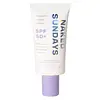Naked Sundays SPF 50+ Collagen Glow Creme Versus Naked Sundays Cabana Glow Mineral Glow Serum Drops SPF 50
What's inside
What's inside
 Key Ingredients
Key Ingredients

 Benefits
Benefits

 Concerns
Concerns

 Ingredients Side-by-side
Ingredients Side-by-side

Butyl Methoxydibenzoylmethane
UV AbsorberOctocrylene
UV AbsorberPEG-100
HumectantEthylhexyl Salicylate
UV AbsorberDimethicone
EmollientTocopheryl Acetate
AntioxidantEthylhexylglycerin
Skin ConditioningGluconolactone
Skin ConditioningGlyceryl Stearate
EmollientAloe Barbadensis Leaf Polysaccharides
EmollientHydrolyzed Rice Protein
Skin ConditioningHydrolyzed Soy Protein
HumectantPhenoxyethanol
PreservativePotassium Cetyl Phosphate
EmulsifyingProline
Skin ConditioningWater
Skin ConditioningSodium Benzoate
MaskingSodium Polyacrylate
AbsorbentCitrullus Lanatus Fruit Extract
Skin ConditioningButyl Methoxydibenzoylmethane, Octocrylene, PEG-100, Ethylhexyl Salicylate, Dimethicone, Tocopheryl Acetate, Ethylhexylglycerin, Gluconolactone, Glyceryl Stearate, Aloe Barbadensis Leaf Polysaccharides, Hydrolyzed Rice Protein, Hydrolyzed Soy Protein, Phenoxyethanol, Potassium Cetyl Phosphate, Proline, Water, Sodium Benzoate, Sodium Polyacrylate, Citrullus Lanatus Fruit Extract
Titanium Dioxide 3.3%
Cosmetic ColorantZinc Oxide 14.9%
Cosmetic ColorantAluminum Hydroxide
EmollientButyloctyl Salicylate
Skin ConditioningC12-15 Alkyl Benzoate
AntimicrobialCoco-Caprylate/Caprate
EmollientDimethicone
EmollientDunaliella Salina Extract
Skin ConditioningGlycerin
HumectantEthylhexyl Methoxycrylene
Skin ConditioningEthylhexylglycerin
Skin ConditioningHibiscus Sabdariffa Flower Extract
Skin ConditioningHydroxyacetophenone
AntioxidantIron Oxides
Isododecane
EmollientIsostearic Acid
CleansingLauryl PEG-8 Dimethicone
Magnesium Sulfate
Mica
Cosmetic ColorantPhenoxyethanol
PreservativePolyglyceryl-2 Tetraisostearate
EmollientPolyglyceryl-3 Polyricinoleate
EmulsifyingPropanediol
SolventWater
Skin ConditioningSimmondsia Chinensis Seed Oil
EmollientSodium Benzoate
MaskingSodium Hyaluronate
HumectantStearic Acid
CleansingCI 77891
Cosmetic ColorantTitanium Dioxide 3.3%, Zinc Oxide 14.9%, Aluminum Hydroxide, Butyloctyl Salicylate, C12-15 Alkyl Benzoate, Coco-Caprylate/Caprate, Dimethicone, Dunaliella Salina Extract, Glycerin, Ethylhexyl Methoxycrylene, Ethylhexylglycerin, Hibiscus Sabdariffa Flower Extract, Hydroxyacetophenone, Iron Oxides, Isododecane, Isostearic Acid, Lauryl PEG-8 Dimethicone, Magnesium Sulfate, Mica, Phenoxyethanol, Polyglyceryl-2 Tetraisostearate, Polyglyceryl-3 Polyricinoleate, Propanediol, Water, Simmondsia Chinensis Seed Oil, Sodium Benzoate, Sodium Hyaluronate, Stearic Acid, CI 77891
 Reviews
Reviews

Ingredients Explained
These ingredients are found in both products.
Ingredients higher up in an ingredient list are typically present in a larger amount.
Dimethicone is a type of synthetic silicone created from natural materials such as quartz.
What it does:
Dimethicone comes in different viscosities:
Depending on the viscosity, dimethicone has different properties.
Ingredients lists don't always show which type is used, so we recommend reaching out to the brand if you have questions about the viscosity.
This ingredient is unlikely to cause irritation because it does not get absorbed into skin. However, people with silicone allergies should be careful about using this ingredient.
Note: Dimethicone may contribute to pilling. This is because it is not oil or water soluble, so pilling may occur when layered with products. When mixed with heavy oils in a formula, the outcome is also quite greasy.
Learn more about DimethiconeEthylhexylglycerin (we can't pronounce this either) is commonly used as a preservative and skin softener. It is derived from glyceryl.
You might see Ethylhexylglycerin often paired with other preservatives such as phenoxyethanol. Ethylhexylglycerin has been found to increase the effectiveness of these other preservatives.
Phenoxyethanol is a preservative that has germicide, antimicrobial, and aromatic properties. Studies show that phenoxyethanol can prevent microbial growth. By itself, it has a scent that is similar to that of a rose.
It's often used in formulations along with Caprylyl Glycol to preserve the shelf life of products.
Sodium Benzoate is a preservative. It's used in both cosmetic and food products to inhibit the growth of mold and bacteria. It is typically produced synthetically.
Both the US FDA and EU Health Committee have approved the use of sodium benzoate. In the US, levels of 0.1% (of the total product) are allowed.
Sodium benzoate works as a preservative by inhibiting the growth of bacteria inside of cells. It prevents the cell from fermenting a type of sugar using an enzyme called phosphofructokinase.
It is the salt of benzoic acid. Foods containing sodium benzoate include soda, salad dressings, condiments, fruit juices, wines, and snack foods.
Studies for using ascorbic acid and sodium benzoate in cosmetics are lacking, especially in skincare routines with multiple steps.
We always recommend speaking with a professional, such as a dermatologist, if you have any concerns.
Learn more about Sodium BenzoateWater. It's the most common cosmetic ingredient of all. You'll usually see it at the top of ingredient lists, meaning that it makes up the largest part of the product.
So why is it so popular? Water most often acts as a solvent - this means that it helps dissolve other ingredients into the formulation.
You'll also recognize water as that liquid we all need to stay alive. If you see this, drink a glass of water. Stay hydrated!
Learn more about Water